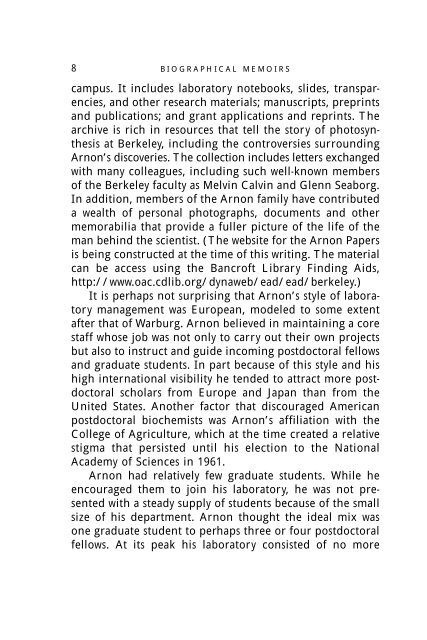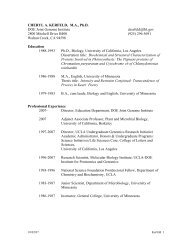DANIEL I ARNON 1910–1994
80 arnon - Department of Plant & Microbial Biology
80 arnon - Department of Plant & Microbial Biology
- No tags were found...
Create successful ePaper yourself
Turn your PDF publications into a flip-book with our unique Google optimized e-Paper software.
8 BIOGRAPHICAL MEMOIRS<br />
campus. It includes laboratory notebooks, slides, transparencies,<br />
and other research materials; manuscripts, preprints<br />
and publications; and grant applications and reprints. The<br />
archive is rich in resources that tell the story of photosynthesis<br />
at Berkeley, including the controversies surrounding<br />
Arnon’s discoveries. The collection includes letters exchanged<br />
with many colleagues, including such well-known members<br />
of the Berkeley faculty as Melvin Calvin and Glenn Seaborg.<br />
In addition, members of the Arnon family have contributed<br />
a wealth of personal photographs, documents and other<br />
memorabilia that provide a fuller picture of the life of the<br />
man behind the scientist. (The website for the Arnon Papers<br />
is being constructed at the time of this writing. The material<br />
can be access using the Bancroft Library Finding Aids,<br />
http://www.oac.cdlib.org/dynaweb/ead/ead/berkeley.)<br />
It is perhaps not surprising that Arnon’s style of laboratory<br />
management was European, modeled to some extent<br />
after that of Warburg. Arnon believed in maintaining a core<br />
staff whose job was not only to carry out their own projects<br />
but also to instruct and guide incoming postdoctoral fellows<br />
and graduate students. In part because of this style and his<br />
high international visibility he tended to attract more postdoctoral<br />
scholars from Europe and Japan than from the<br />
United States. Another factor that discouraged American<br />
postdoctoral biochemists was Arnon’s affiliation with the<br />
College of Agriculture, which at the time created a relative<br />
stigma that persisted until his election to the National<br />
Academy of Sciences in 1961.<br />
Arnon had relatively few graduate students. While he<br />
encouraged them to join his laboratory, he was not presented<br />
with a steady supply of students because of the small<br />
size of his department. Arnon thought the ideal mix was<br />
one graduate student to perhaps three or four postdoctoral<br />
fellows. At its peak his laboratory consisted of no more




